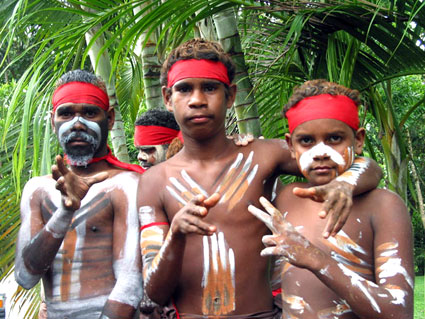
By Manpreet Atwal Winter 2008
The Insight of Tiwi Marriage
Two Types of Tiwi Marriages
Tiwi Females and Marriage
Citations
The Aboriginal Tiwi people resided within areas of Australia during the seventeenth and eighteenth centuries, and defined themselves as “we the only people” (C. W. M. Hart et al: 1988, 12). The Tiwi were separated in groups known as tribes or bands. These terms describe the way in which the Tiwi were subdivided amongst each other. Groups mainly consisted of all family members making up one band. Neighboring bands created a sort of tribe. One Tiwi family may have consisted of numerous amounts of family members, such as a husband, a wife, many children, and even relatives at times. For the most part, the Tiwi people lived within a patrilineal society, which refers to a society run by a male figure, such as a wife’s husband, a female’s brother, or uncle. Therefore, the marriage of a female would either be arranged by her father or brother. She would never be married within the same band. Fathers were known to arrange the wedding of their daughter before or prior to her birth.
Females could be seen as objects that men moved around in order to gain more wealth. Whether a female was a daughter or a wife, she was traded in or moved around in order for the father or husband to benefit. Thus, the household of the Tiwi people was huge in size. In relation to an American household, “Tiwi households were seen to live, hunt, eat, and sleep together”. The members of a Tiwi family were similar to that of an American household, “yet there were no orphans, maiden aunts, or ancient widows because such characters did not exist in the Tiwi culture”. The reasons of no orphans and other such relationships not existing within the Tiwi culture are discussed more thoroughly through the link leading to the Two Types of Marriages (C. W. M. Hart: 1988, 16).
Looking at the Tiwi culture in Canada during the same time frame, Tiwi women were believed to be marrying outside of their culture. According to researcher Sylvia Van Kirk, during the early seventeenth century, there was a lack of French women in Canada, and therefore the French men seeked wives that were capable of sewing, knitting, etc. With that, the words of a Frenchman named Champlain, were famously quoted stating to the Tiwi that, “Our young men will marry your daughters and we shall be one people” (Sylvia Van Kirk: 2002, 2). The quote gives an example of how culture is defined in Anthropology, with the aboriginal culture suffering from a cultural loss, or the act of abandonment of an existing practice or trait (William A. Haviland et al: 2005, 401). Acculturation could be seen within the aboriginal society adapting to the French society. This way, the French progressed within their economic trading needs and within society (William A. Haviland et al: 2005, 402).
Though the Tiwi culture changed within Canada, some traditional Tiwi customs remained and were even seen in the Frenchmen. Similar to the males of the Tiwi society, Frenchmen also took aboriginal women into their household, portraying a patrilocal type of marriage, where the women could be seen to live within their husband’s home along with his parents. By having the Aboriginal women contribute to the labor, this enabled the Frenchmen to succeed in trading. In the eyes of the French, the Tiwi culture could be seen to have been lost, yet the treatment of women remained the same. They were married within a different “crop” of husband’s, yet served as they would serve in an aboriginal household (C. W. M. Hart et al: 1988, 20).